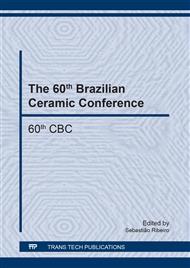p.39
p.44
p.50
p.55
p.60
p.65
p.71
p.77
p.82
Study of the Addition Effect of Fe2O3 and Al2O3 Originated from Pectin Citrus in the Glassy Phase on the Microestructural Development and in the Mechanical Characteristics of the Triaxial Ceramics
Abstract:
Triaxial ceramics are multiphased materials produced from natural raw material. That a small modification as much concerning in the composition from raw material a ceramic mass, may change several properties from ceramics. Thus, was included into the ceramic mass Al2O3 and Fe2O3, however both originated from pectin citrus plus salt the intended respective metal source. These oxides have a particular physical characteristic as high softness and high porosity. In addition to the ceramic mass containing 10% of clay, 25% kaolin, 35% feldspar and 30% of alumina (Ind. Alcoa) was inserted 6% of Fe2O3 and the full replacement of commercial alumina by Al2O3(pec). The result from these oxides are satisfactory mainly. Influencing in thermal contraction, in the reduction of the residual porosity and changing the final color inthe product.
Info:
Periodical:
Pages:
60-64
Citation:
Online since:
January 2018
Keywords:
Price:
Сopyright:
© 2018 Trans Tech Publications Ltd. All Rights Reserved
Share:
Citation:


